Sandra Merville Hart's Blog, page 32
May 10, 2022
Ashes of Glory by Ernest B. Furgurson
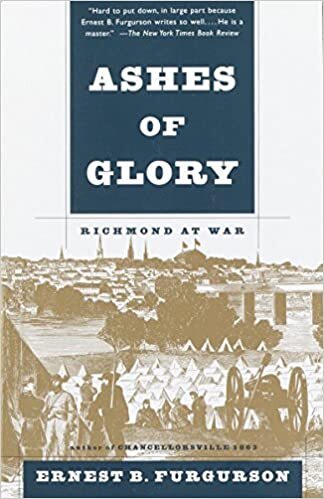
Review by Sandra Merville Hart
Richmond at War
I loved this book! This nonfiction book brings the Confederate capital of Richmond, Virginia, during the Civil War (1861-1865) to life.
Furgurson arranged the book in mostly chronological order, which makes it an easy read. The author has a storyteller’s flair for opening up history. It was a page-turner for me.
The author gives details from history that bring the scenes vividly to life for readers. Descriptive details that involve the senses transport readers to the difficult days of the war. The author includes details such as distances between Richmond locations—such as a “block and a half away”—that were a real treasure for me as a historical author.
In fact, I bought this book for research purposes. My “Spies of the Civil War” series has two books set in Richmond in 1862—Boulevard of Confusion, Book 2 and Byway to Danger, Book 3. I took lots of notes and highlighted passages testifying to how it enriched my understanding of what Richmond citizens faced during the war.
Well-written. Well-researched. This is recommended for anyone interested in learning about the Civil War in Richmond, Civil War research, and history lovers!

May 9, 2022
Spies of the Civil War Series Book 2 Releases Today!
 by Sandra Merville Hart
by Sandra Merville HartI’m thrilled to announce that Boulevard of Confusion, Book 2 of my new “Spies of the Civil War” releases today, May 10, 2022!
Though the series is about a fictional family, there are actual historical spies who touch the stories.
Boulevard of Confusion is set in the Confederate capital of Richmond, Virginia, in 1862. Citizens establish new hospitals to care for wounded Confederate soldiers and new prisons to house Union prisoners. The city’s population swells and Southern citizens don’t know who to trust—and rightly so, for many Union spies now roam the streets and sleep in Richmond hotels.
Here’s a bit about the book:
In times of war, is anything as it seems?
Her aunt’s invitation to Richmond is just the change Beatrice Swanson needs after her brother’s release from a Union prison. Bea’s father agrees to the trip with a condition—one that tosses her emotions into swirling confusion.
Though Jay Nickson wants to serve his country as a Confederate soldier, his work is too important to the government. Bea’s interest in his job, which includes secrets that would benefit the Union, arouses his suspicions. Is she spying for the North? His growing feelings for her are hard to squelch.
Though she participates in activities to benefit Confederate soldiers, Bea struggles with her own loyalties and her father’s demands. Where does her cousin, Meg, go on her solitary errands? Bea’s own growing love for Jay, a Southerner, only adds to her confusion. Tensions escalate in Richmond as the Union army approaches, drawing her into more secrecy. Where does her allegiance lie? And how will she be forced to prove it?
Nothing in war is simple…especially when the heart becomes entangled.
Order your copy today on Amazon, Apple Books, Kobo, or Barnes and Noble!
May 3, 2022
Beneath the Veil of Smoke and Ash
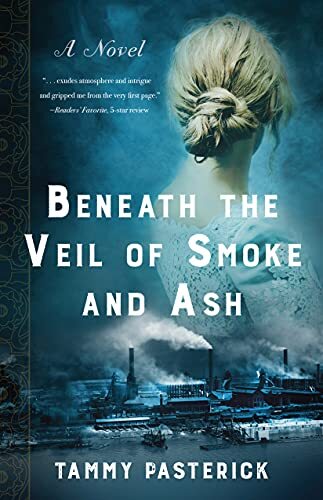
by Sandra Merville Hart
It’s 1910 and Sofie has nightmares about her father’s job at a Pennsylvania steel mill. She fears for his safety at the mill where accidents occur that could be prevented.
Her mother’s job as a housekeeper for a bachelor in charge of safety and inspections at her father’s mill keeps her from the family for long hours. Sofie’s aunt, who takes care of her and her little brother while her parents are working, is actually more of a mother to them because her mother has always remained distant from her children and Sofie wonders if she loves them.
It seems all the immigrant families in the small Pennsylvania steel town are just as poverty-stricken as Sofie’s. Pole, her best friend, has his own problems. After his mother’s death, there’s no one to save him from his father’s drinking and abuse.
A gripping, well-written story with believable characters that leap off the page. Some characters readers will love and pull for. There are several characters readers will hate.
Readers are taken on a tough journey with the characters. It’s a multi-layered story, told in multiple points of view. There’s tragedy, grief, and abuse. The story also deals with physical and mental illness…and the struggle to forgive deep wounds.
I was captivated by the story from the first page. I couldn’t put it down.
It’s not an easy read. There is some language and violence.
This one will stay with me.
May 1, 2022
Easter Traditions in the Victorian Era

by Sandra Merville Hart
Christians celebrate the resurrection of Jesus on Easter every spring. Though it’s always on Sunday, the date varies. The actual date depends upon when the full moon following the vernal equinox appears. Easter is celebrated on the first Sunday after that full moon.
The Easter Lily is a popular flower because it symbolizes life after death. Lilies grow from a bulb buried in the ground. They bloom in the spring. Large white blooms symbolize purity because Jesus never sinned. The trumpet-shaped flowers resound with the good news of the risen Savior.
Easter was a fun celebration for Victorians. They gathered for traditional meals. They sent Easter greeting cards containing Bible verses and decorated with crosses. Drawings of bunnies in Easter greetings first appeared in the late 1700s when a publisher added one to writing stationery.
Children loved the holiday back in the Victorian era just as they do today. They enjoyed Easter egg hunts and egg rolling contests.
Dying the eggs was part of the celebration. Young children dyed them using a variety of fruits and vegetables. Beets and cranberries were used because of their strong colors. Peels from oranges and lemons provided dyes. Though blueberries and blackberries weren’t specifically mentioned in my sources, these were probably used as well. Imagine the fruits and vegetables that leave stains on fingers for other ideas of dyes.
Along with the dyes, children drew crosses, churches, flowers, and bunnies on the Easter eggs.
It was a joy to include an Easter celebration in Boulevard of Confusion, Book 2 in my “Spies of the Civil War” series. Children and adults enjoyed dying Easter eggs after church services in my novel.

Sources
“Easter Traditions During the Victorian Era,” WorldHistory.us, 2021/08/13 https://worldhistory.us/european-history/easter-traditions-during-the-victorian-era.php.
“Victorian Era Easter Celebrations,” Victorian Era, 2021/08/13 http://victorian-era.org/victorian-era-easter-celebrations.html.
Wells, Mary Shannon. “Everything You Need to Know about the Easter Lily,” Southern Living, 2022/04/14 https://www.southernliving.com/holidays-occasions/easter/easter-lily-meaning.
April 27, 2022
Confederate Spy Rose Greenhow in Boulevard of Confusion
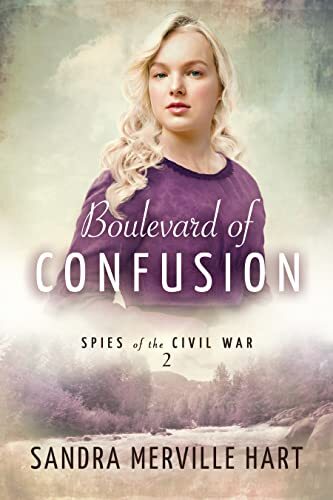
by Sandra Merville Hart
Boulevard of Confusion, Book 2 of my new “Spies of the Civil War” series releases on May 10, 2022. Here’s a bit of the historical background for the story leading up to its release.
Though series is about a fictional family, there are actual historical spies who touch the stories.
Boulevard of Confusion is set in Richmond, Virginia, the capital of the Confederacy in 1862. With its Southern setting, one might imagine all the citizens supported the Confederates. Surprisingly, a number of Union spies and Union supporters—called Unionists—lived in Richmond.
Just as the historical Confederate spy Rose O’Neal Greenhow played a part in Avenue of Betrayal Book 1, her story also touches the characters in Boulevard of Confusion Book 2.
Perhaps the most famous female Confederate spy who lived in Washington DC when the Civil War began was Rose O’Neal Greenhow. She agreed to send messages based on a cipher. She built up a spy network of fifty people, the largest of the war. She was caught and imprisoned in Washington DC.
Rose learned battle plans for Bull Run and passed this vital information to Confederate General Beauregard. The First Battle of Bull Run was a Confederate victory.
She was caught and imprisoned at Washington’s Old Capitol prison. The Federals decided to send her South.
On June 4, 1862, she arrived in Richmond, where she was taken to the best hotel. Confederate President Jefferson Davis called her the next day, saying, “But for you there would have been no battle of Bull Run.” Rose wrote that his words made up for all she’d endured.
The following year President Davis sent her to Europe. She took letters from him to France and England. She received money from them to aid the South.
In October 1, 1864, Rose returned on the Condor, a blockade runner. Unfortunately, the USS Niphon, a Union gunboat, came close to their position on Cape Fear River. While Confederate soldiers from nearby Fort Fisher fired on the Union gunboat, Rose asked the captain for a lifeboat for herself and two other Confederate agents. Two hundred yards of rough waters were between the boat and the shore. Despite his initial refusal, she convinced the captain to provide a boat.
A powerful wave overturned the lifeboat. They swam for shore. Unfortunately, Rose had a bag of gold sovereigns tied around her waist underneath a heavy silk dress. Though she was a good swimmer, she drowned due to the extra weight while her companions made it to safety.
Her body washed ashore the next day. A Confederate soldier found the bag of gold and took it. A search party later found the body. When the soldier discovered Rose’s identity, he returned the sovereigns.
She was buried in Oakdale Cemetery in Wilmington with full military honors.
Rose’s story touches our fictional family again when she arrives in Richmond in June of 1862.
-Sandra Merville Hart
Sources
Monson, Marianne. Women of the Blue & Gray, Thorndike Press, 2018.
Winkler, H. Donald. Stealing Secrets, Cumberland House, 2010.
Zeinert, Karen. Those Courageous Women of the Civil War, The Millbrook Press, 1998.
April 26, 2022
The Confederate State of Richmond by Emory M. Thomas
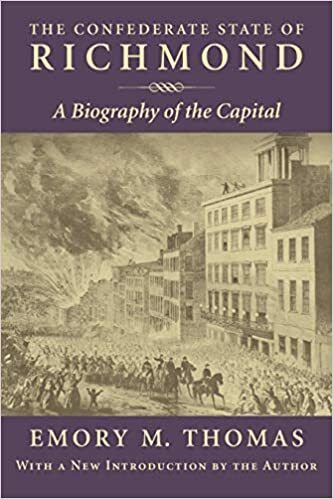
Review by Sandra Merville Hart
A Biography of the Capital
This nonfiction book reports on events that took place in the Confederate capital of Richmond, Virginia, during the Civil War (1861-1865).
Thomas arranged the book in mostly chronological order, which makes it an easy read.
Filled with interesting details about important leaders and events, this book also includes charts, maps, and, places, and Richmond businesses. The author even included military buildings, hospitals, newspapers, businesses, owners’ names, and the street location—a treasure for historical authors!
In fact, I bought this book for research purposes. My “Spies of the Civil War” series has two books set in Richmond in 1862—Boulevard of Confusion, Book 2 and Byway to Danger, Book 3. I took lots of notes and highlighted passages. The book enriched my understanding of what Richmond citizens faced during the war.
Recommended for anyone interested in learning about the Civil War in Richmond, Civil War research, and history lovers.

April 19, 2022
The Chamomile by Susan F. Craft
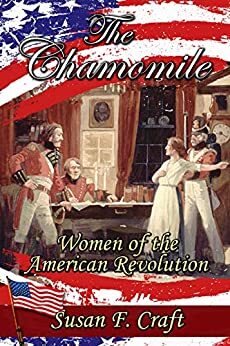
Review by Sandra Merville Hart
Book 1 in “Women of the American Revolutions” Series
Lilyan Cameron’s loyalties belong to the colonies during the Revolutionary War. Her brother Andrew fights for the militia, but when he is captured by the British and held prisoner in deplorable conditions on one of their ships, Lilyan doesn’t know where to turn for help.
Captain Nicholas Xanthakos also fights for the militia. He and others plan how they can save Andrew and those captured with him. He enlists Lilyan to help. She doesn’t need much persuasion—she’ll do anything to save her brother.
There’s a lot of action and adventure in this story. It also shows how the colonists lived and made their living. Some of the detail, while fascinating, tends to slow the action.
The story beautifully demonstrates the courage of many men and women, whether they fought for the militia or not.
Multiple twists and turns in the story made this a page-turner for me. Tragedy, heartache, and difficulties escalate as the story unfolds. I felt that the initial relationship between Lilyan and Nicholas moved quickly for the time period.
As a history buff, the book snagged my interest. I look forward to reading the next book in the series.
April 17, 2022
Author’s Inspiration for Avenue of Betrayal

by Sandra Merville Hart
I’m often asked where ideas for my stories originate. That answer varies because inspiration comes from unexpected sources. Searching for inspiration seems to make it more elusive. Story ideas usually happen when I’m doing something unrelated to my books, like visiting a museum or historical home while on vacation.
Ideas for this series stemmed from research for a “Civil War Women” series of articles I wrote for my blog. There are many women from the North and South featured in that series—and many more that deserve recognition. What surprised me was the number of known female spies from both sides. It’s likely that many others either didn’t seek praise after the war or feared retribution and never revealed their activities.
Rose Greenhow, a Confederate spy living in Washington DC (Washington City, as it was called at that time) in 1861, created an impressive spy network. Coded messages were sent on a “Secret Line.” Several couriers in a chain passed on messages in common places such as docks, taverns, and farmhouses.
Rose’s spy network from Boston to New Orleans was the largest in the war—48 women and 2 men.
Allan Pinkerton, head of Lincoln’s Intelligence Service, was given the task to find Confederate spies and he placed Greenhow under surveillance.
She was arrested in August of 1861.
Though the series is about a fictional family, there are actual historical spies who touch the stories. Rose is one of them.
Avenue of Betrayal is set in Washington City (Washington DC) in 1861, where a surprising number of Confederate sympathizers and spies lived.
Through both real and fictional characters, this series will highlight activities spies were involved in and some of the motives behind their decisions.
I invite you to read Avenue of Betrayal and the rest of the series that will soon follow. I’d love to know what you think!

Back Cover Blurb for Avenue of Betrayal
Betrayed by her brother and the man she loves …
whom can she trust when tragedy strikes?
Soldiers are pouring into Washington City every day and have begun drilling in preparation for a battle with the Confederacy. Annie Swanson worries for her brother, whom she’s just discovered is a Confederate officer in his new home state of North Carolina. Even as Annie battles feelings of betrayal toward the big brother she’s always adored, her wealthy banker father swears her and her sister to secrecy about her brother’s actions. How could he forsake their mother’s abolitionist teachings?
Sergeant-Major John Finn camps within a mile of the Swansons’ mansion where his West Point pal once lived. Sweet Annie captured his heart at Will’s wedding last year and he looks forward to reestablishing their relationship—until he’s asked to spy on her father.
To prove her father’s loyalty to the Union, John agrees to spy on the Swanson family, though Annie must never know. Then the war strikes a blow that threatens to destroy them all—including the love that’s grown between them against all odds.
Available on Amazon and other retailers.
April 13, 2022
Transcontinental Railroad

by Sandra Merville Hart
Asa Whitney, a New York merchant, planted the idea of a transcontinental railroad when he petitioned Congress for federal funding of a sixty-mile strip in 1845, but it wasn’t until Theodore D. Judah caught the vision that things began to happen. He believed the Donner Pass was the perfect area for the railroad to pass through the Sierra Nevada mountains, and, as the engineer of the Sacramento Valley Railroad, he wanted to build it.
He brought Leland Stanford, Charles Crocker, Collis P. Huntington, and Mark Hopkins in on the project, leading to the establishment of Central Pacific Railroad Company of California.
Congress passed the first Pacific Railway Act on July 1, 1862. It stated the Union Pacific was to start in Omaha, Nebraska, and build toward the west. The Central Pacific started in Sacramento, California, and built toward the east to meet them roughly halfway.
The second Pacific Railway Act (July 2, 1864) doubled the land grants to 12,800 acres for every mile of track built. They also received $48,000 in government bonds for each mile. This increased the competition between the two companies.
The Civil War hampered Union Pacific’s efforts to build. Though they began in December of 1863, little was accomplished for the remaining two years of the war.
The western team began about a month before. Sadly, the man who had laid so much groundwork for the project didn’t see it to completion. Judah died of yellow fever in November of 1863, shortly after Central Pacific pounded the first spikes.
The Sierra Nevada mountains slowed Central Pacific’s progress. They hired Chinese workers for this grueling task. Nine tunnels were blasted the mountains in order for the track to be laid.
Once the war ended, the Union Pacific made progress westward across the prairie. Civil War veterans and Irish immigrants had to cope with attacks from Native Americans. Cheyenne, Sioux, and Arapahoe were among the attacking tribes.
Union Pacific workers had their own mountain range to contend with—the Rockies. Even with these obstacles, the group from the east was in Wyoming in the summer of 1867, and had laid almost four times the miles of track.
Once Central Pacific made it to the other side of the Sierra Mountains in June, they made significant progress.
The competition was on now. Unfortunately, the workmanship suffered and some the sections were later rebuilt.
In March of 1869, President Ulysses S. Grant told the two companies to agree on a meeting point. They chose Promontory, Utah. A symbolic gold spike was driven in a special “Golden Spike Ceremony” on May 10, 1869. It linked both railroads, marking the completion of the Transcontinental Railroad.
The hero in my novel, Avenue of Betrayal, Book 1 of my “Spies of the Civil War” series, dreams of participating in building the Transcontinental Railroad. The fictional Union officer hopes that the war doesn’t last so long that he misses his opportunity. As you read in this article, Civil War veterans were used to build the railroad after the war ended. I was thrilled to use such an important part of our history in the story.

Sources
“Central Pacific Railroad,” Encyclopaedia Britannica, 2022/02/22 https://www.britannica.com/topic/Central-Pacific-Railroad.
History.com Editors. “Transcontinental Railroad,” History.com, 2022/02/22 https://www.history.com/topics/inventions/transcontinental-railroad.
“Pacific Railway Acts,” Encyclopaedia Britannica, 2022/02/22 https://www.britannica.com/event/Pacific-Railway-Acts.
“The Transcontinental Railroad,” Library of Congress, 2022/02/26 https://www.loc.gov/collections/railroad-maps-1828-to-1900/articles-and-essays/history-of-railroads-and-maps/the-transcontinental-railroad/.
“Transcontinental Railroad,” History.net, 2020/06/19 https://www.historynet.com/transcontinental-railroad.
“Union Pacific Railroad Company, Encyclopaedia Britannica, 2022/02/22 https://www.britannica.com/topic/Central-Pacific-Railroad.
April 12, 2022
Medium Well Done by Eddie Jones
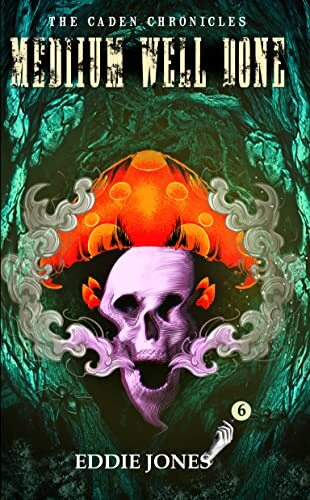
by Sandra Merville Hart
The Caden Chronicles
Book 6
I’ve read other books in this series so I settled in to try solve the mystery along with fifteen-year-old Nick.
The story begins with Nick witnessing a séance in a cemetery. He can hear the words used to “awaken” a spirit but I don’t know the meaning of those words.
Nick doesn’t believe in ghosts and figures his friend brought him here to see a staged performance. Then his friend disappears right afterward and it appears she died in a hit and run but no one can find her body.
This isn’t the first time Nick has found himself in the middle of a murder investigation and readers of the series hope it isn’t the last.
Jones has written the book to appeal to middle-grade and teen readers, both boys and girls. There is plenty of mystery, adventure, and danger to hold their interest. I like that the seeming supernatural portions of the story are explained at the end. If parents are worried about that aspect, I’d suggest reading it first.
I enjoy stories that invite me to try to figure out “whodunit” and this one did.



